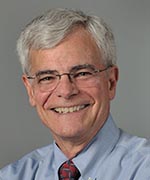From the Deputy Director for Intramural Research
Collecting and Interpreting NIH History

The NIH has a proud and intriguing history. Fittingly, we also have an Office of NIH History that documents, preserves, and interprets our many significant achievements. And the collections run deep.
Formally known as the Office of NIH History and DeWitt Stetten Jr. Museum of Medical Research (ONHM), the office captures the memory of who worked with whom, of when the work was conducted, and of what tools they used. The material heritage in its collections include instruments, objects, images, films, oral histories, notebooks, illustrations, and myriad documents. (See its website at https://history.nih.gov).
These exhibits and displays that you see around the Bethesda campus—for example, the original Santiago Ramón y Cajal drawings in Building 35, the exhibits on Christian Anfinsen and Michael Potter in Building 10, Al Kapikian’s Siemens 1-A electron microscope in Building 50, and the biotechnology showcase display in Building 31—all are curated by the ONHM.
And the historical facts that you may hear sprucing up an NIH director’s keynote address or read in a prominent NIHer’s obituary are often provided by the ONHM. The ONHM is also the go-to source for old photographs used in books and by the news media.
The ONHM focuses its research and collecting specifically on the NIH community. This focus solely on the NIH differentiates the office from the NIH National Library of Medicine (NLM), which has a congressional mandate to collect, preserve, and make accessible the broad record of medical history from all times and places. The ONHM works closely with NLM to ensure that important historical resources associated with the NIH are preserved and made accessible to interested researchers. (See article on “Historical Medical Films,” in this issue of the NIH Catalyst.]
The ONHM builds its collection mostly through networking. The staff are happy to meet with those planning to retire, and they regularly interact with the NIH community through events such as the NIH Research Festival. They also meet with family members of deceased NIH staff to collect personal memorabilia such as private photographs and other treasured items that can provide extra charm and insight to historical exhibits.
The staff keep their eyes and ears open to planned moves or demolitions, too, and use these opportunities to ensure objects and documents of historical significance are not discarded. Some items, such as a set of handmade, early 20th-century manometers used by one of the founders of carbohydrate chemistry, Claude Hudson, were literally rescued from the trash.
The ONHM relies on a network of archivists and museum specialists to assess and interpret its collection, as well as on an NIH-wide collections committee to ascertain the past significance of now-obsolete equipment and to advise us what to collect to represent today’s science for future historians. More than 95 percent of our collected objects are stored off-campus. Should we ever find space on campus for a physical museum, we would have enough objects to reconstruct an NIH laboratory from every decade dating back to 1900!
Given the limited space, we cannot keep most objects and documents. All are assessed, though. Some documents are sent to the National Archives and Records Administration. Some are transferred to the NLM’s History of Medicine Division.
Perhaps surprisingly given the age of the NIH—132 years as of August 2019, dated to Joseph Kinyoun’s Hygienic Laboratory, our direct precursor—the ONHM was created only 33 years ago, in 1986, and moved into the Office of Intramural Research in 2006. The ONHM is now housed in Building 60, nicknamed the Cloister, formally designated as the Mary Woodard Lasker Center for Health Research and Education, itself an historic building. Chris Wanjek is acting director of the office, which has a small staff consisting of a curator of collections (Michele Lyons), an expert in creating museum-quality exhibits (Hank Grasso), and an archivist (Barbara Harkins). Many helpful volunteers support our oral-history projects, the photo archives, and website updates.
The ONHM welcomes your engagement. Before you dispose of old equipment (especially from the early 2000s), reports, photographs, or even instrument manuals, contact the ONHM to see if it could be of historical value to the NIH story. Take charge of your own history by documenting your laboratories each year with a photograph. And identify each member for posterity…while your memory still serves you well.
And most important, let’s keep making history!
Got history? Contact Michele Lyons, ONHM curator of collections, at history@mail.nih.gov.
This page was last updated on Monday, April 4, 2022
